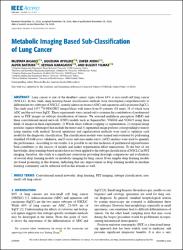Metabolic Imaging Based Sub-Classification of Lung Cancer

Göster/
Erişim
info:eu-repo/semantics/openAccessTarih
2020Yazar
Bicakci, MustafaAyyildiz, Oguzhan
Aydin, Zafer
Basturk, Alper
Karacavus, Seyhan
Yilmaz, Bulent
Üst veri
Tüm öğe kaydını gösterÖzet
Lung cancer is one of the deadliest cancer types whose 84% is non-small cell lung cancer (NSCLC). In this study, deep learning-based classification methods were investigated comprehensively to differentiate two subtypes of NSCLC, namely adenocarcinoma (ADC) and squamous cell carcinoma (SqCC). The study used 1457 F-18-FDG PET images/slices with tumor from 94 patients (88 men), 38 of which were ADC and the rest were SqCC. Three experiments were carried out to examine the contribution of peritumoral areas in PET images on subtype classification of tumors. We assessed multilayer perceptron (MLP) and three convolutional neural network (CNN) models such as SqueezeNet, VGG16 and VGG19 using three kinds of images in these experiments: 1) Whole slices without cropping or segmentation, 2) cropped image portions (square subimages) that include the tumor and 3) segmented image portions corresponding to tumors using random walk method. Several optimizers and regularization methods were used to optimize each model for the diagnostic classification. The classification models were trained and evaluated by performing stratified 10-fold cross validation, and F-score and area-under-curve (AUC) metrics were used to quantify the performance. According to our results, it is possible to say that inclusion of peritumoral regions/tissues both contributes to the success of models and makes segmentation effort unnecessary. To the best of our knowledge, deep learning-based models have not been applied to the subtype classification of NSCLC in PET imaging, therefore, this study is a significant cornerstone providing thorough comparisons and evaluations of several deep learning models on metabolic imaging for lung cancer. Even simpler deep learning models are found promising in this domain, indicating that any improvement in deep learning models in machine learning community can be reflected well in this domain as well.

















